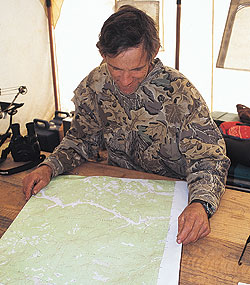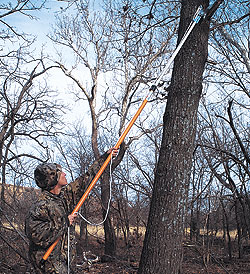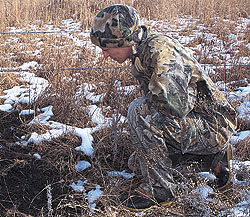February 24, 2011
By Eddie Claypool
The season may be over, but the work is just beginning.
By Eddie Claypool
 Before heading to the field, when you're in the field and after returning home, topographic maps and aerial photos should be used to your advantage. Mark down any pertinent information and keep a journal of your scouting forays. |
It seems to me we're living in a society that's continually looking for the easy way out. Even in our bowhunting pursuits, we rarely look to attain success the old fashioned way -- through the development of good woods savvy. After all, doesn't that require a lot of time and work? Yuk!
We all want to be expert whitetail bowhunters, right? We're passionate about our pursuit, and we want to be admired for our ability to bring home the bacon (and bone), right? We want to feel the extreme satisfaction that comes from becoming a consummate outdoorsman, right? Well then, read on and I'm going to highlight the single biggest thing you can do to accomplish all these goals -- post-season scouting. It's not rocket science and it's not easy, but it'll darn sure get you where you want to be.
Advertisement
Please don't think I'm blowing hot air, because for the past 20 years I've lived a hunting lifestyle that proves a working-class stiff like me can enjoy top-end success by combining a good work ethic with common sense. As the cold winds of winter blow and everyone else is hanging it up for the year, I turn up the heat a notch or two.
The Big Picture Approach
For many years, I had it all backwards. I'd start scouting a few weeks before the season, then jump in a tree and hope for the best. After a month or so of this method, I would start to lose interest just when I should have been getting really serious. By mid-November, my pre-season scouting information was pretty much worthless, so I'd get down and scout some more. Grabbing hold of a little bit of new rut sign, I'd once again get elevated and wait. Trouble was, I was always one step behind my quarry. As the rut wound down in early winter, in a fit of desperation I'd abandon my stand locations and scout again. Sometimes this approach worked. Most of the time, it didn't.
Advertisement


READ: Learning From Your Past Season


Now don't get me wrong; pre-season and in-season scouting have their places. But those types of scouting provide only a quick snapshot into the plotlines of a much, much bigger picture. It's only when the show is over, and we have absorbed the ending, that we can fully understand what was really going on during each stage of the act. And only then can we truly understand what could have been changed to alter the outcome. OK, now let's apply this to bowhunting.
 The fresh sign of the previous season doesn't lie. There is no substitute for getting out in the field and examining the evidence in person. This type of dedicated effort will pay big dividends in the future. |
At the end of each archery season, a potpourri of information is available at our fingertips. An entire mosaic of the local deer herd's movement patterns is laid out before us, awaiting our discovery and interpretation. At no other time of year can we find a more opportune time to make hardcore intrusions into our hunting areas. At no other time of year can we do more to make reservations for success in the future.
Know The Land
During a lifetime spent afield, I've truly come to appreciate the close relationship that exists between the habitat and the animals that call it home. In light of that, one of the first things I demand from my post-season forays is an intimate knowledge of my hunting grounds. Since it's a fact that all deer live in and move through their habitat in direct relation to the topography, ever-changing food sources and available security cover, it goes without saying I need to have a complete understanding of the area I'm hunting.
To accomplish this daunting task, I go afield each winter with aerial photos and topographic maps, systematically scanning every acre while making careful notes about everything I learn. After I'm completely familiar with the lay of the land, I make a second, slower pass over the area, carefully studying every bit of deer sign (both new and old) in the area. Important vegetative and terrain features are marked down on my maps.
 When you've done the footwork and learned where the best ambush locations are, get busy preparing future stand sites. Don't wait until late summer or fall to do this kind of intrusive work. |
Areas that provide security, solitude and food and water sources are noted. Natural barriers, funnels and bottlenecks are recorded. Ditto for entry and exit routes into different quadrants of my area. I mark my maps with all this information so I can later use the sheets like a connect-the-dots puzzle.
There is a lot to be said about simply spending time in the field. As you gather your data and develop an intimate knowledge of your hunting area and the deer that live in it you'll build a sense of confidence and the ability to make solid decisions that will, in turn, take your odds of success on quality bucks to the next level.
Turning Information Into Action
As I begin to digest all this information and combine it with what I learned from the past season's observations, the "big picture" begins to become much clearer in my mind. Now, I make notations in a separate journal concerning my thoughts on a plan of attack for the next season. Notes on any possible changes (such as crop rotat
ions, mast production, human activity, etc.) that might occur to alter deer movement in the next year are recorded.
All these things can prove invaluable, because the passing of time has a way of dulling the memory. Many times it has been months later, as I went back over these notes, that I remembered small details that would make a big difference on future hunts.
Once I'm confident I know my hunting property like the back of my hand, it's time to turn this knowledge into action. While the vegetation is still down and the weather is still cool, I grab my tools -- pole, hand and chain saws -- and head to a few locations I have classified as mature buck travel corridors. Whenever I get to one of these locations, I'll spend a good deal of time carefully studying the approximate area where I intend to place my treestand.
At this point, I'm using my woods savvy to visualize all the possible deer movement scenarios that may occur there. Then, after all this "mind melt" is done, I pick a stand site that gives me the best possible odds for success. After the spot is chosen, I go to work making sure the location is ready to hunt next autumn with minimal disturbance. This is accomplished by erecting a trial stand or two, clearing shooting lanes and carefully pruning access routes.
A few years ago, I spent a good deal of time post-season scouting a property I'd accessed in October. Having hunted the area that fall, I knew there were some mature bucks on the property. During February, I discovered an area that was clearly a big buck travel corridor. A large expanse of prairie that separated two creek drainages was bisected by an abandoned, overgrown railroad bed that provided security for bucks to cross the prairie on their rutting junkets. Large rubs, both new and old, could be found at regular intervals along the length of the railroad grade.
Hurrying back to my truck, I spent the remainder of the day preparing a couple different spots along the rail line for future hunts. Over the next several months, there wasn't a day I didn't dream of the season to come.
When November finally arrived, I spent a great deal of time in my "secret spot." As the month progressed, I had numerous encounters with many excellent bucks. Although I encountered two huge bucks in the spot, I was never able to close the deal. When I made my final hunt in the area on Nov. 27, I harvested a mid-140s-class buck and finished the season seeing more than two dozen bucks from the stand; five of which were record-book contenders.
Without a doubt, all the time and effort I had expended the previous winter had been more than worth it.
